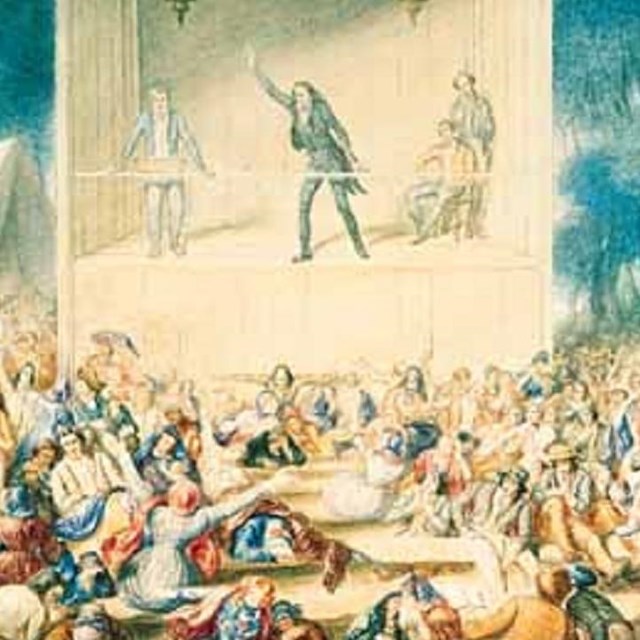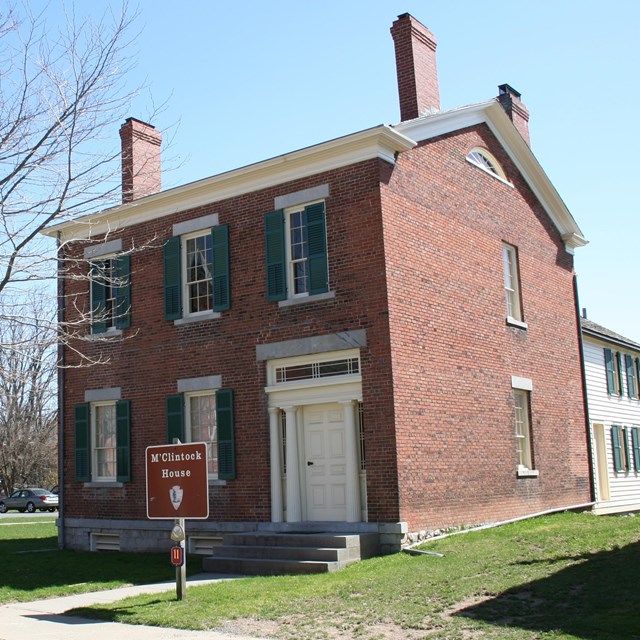Part of a series of articles titled The M'Clintock House & Women's Rights: Opportunities for Learning .
Article
The M'Clintock House & Women's Rights: Opportunities for Learning (1: Introduction)

Before the Civil Rights movements of the 20th century, American women of every race and class did not have the Constitutional right to vote, the right to serve on juries, and equal status before the law as their male peers. It took over a century of activism to achieve those rights and that activism can be traced back to 1848, when advocates for equality held the Women’s Rights Convention in Seneca Falls, New York.
The M’Clintock family home, a humble brick house in upstate New York, was where some leaders of the 19th century movement gathered to rest and reflect during the convention. They met in the M’Clintock House to draft the famous Declaration of Sentiments, which they wrote in the style of the Declaration of Independence: complaints against the rulers and rights the oppressed should be able to exercise. The Declaration of Sentiments was presented at the Seneca Falls Convention that year by women including Elizabeth Cady Stanton, Lucretia Mott, and some men, including Frederick Douglass.
The M’Clintock House today is the site of Women’s Rights National Historical Park, operated by the National Park Service, where learners can investigate the challenges, passions, and methods of American activists.
This material can be used in a formal classroom setting or to simply explore more about the history women’s rights. Interpreters or educators can also use the included activities and discussion questions to engage others in conversations about the topic material.
These opportunities for learning are based on the National Register of Historic Places registration file "Women's Rights Historic Site Thematic Resources" and other sources on the M'Clintock House and women's rights. Aspects of this series are derived from the Teaching with Historic Places lesson plan.
Topics: This learning resource can be used in teaching units on 19th century social reform or women's history. This material can be used in a formal classroom setting or to simply explore more about the history women’s rights. Interpreters or educators can also use the included activities and discussion questions to engage others in conversations about the topic material.
Time period: 1830-1850s
Objectives for students:
-
To describe conditions in upstate New York in the first half of the 19th century that led to the nickname "the Burned-Over District."
-
To examine the issues that led to the First Women's Rights Convention in 1848.
-
To investigate the tactics used by reformers in the early years of the women's rights movement.
-
To discover how issues concerning women's rights played out in their own community.
This learning opportunity meets Common Core Curriculum Standards.
It relates to the following National Standards for History:
- Standard 3A- The student understands the changing character of American political life in "the age of the common man."
- Standard 4B- The student understands how Americans strived to reform society and create a distinct culture.
- Standard 4C- The student understands changing gender roles and the ideas and activities of women reformers.
The lesson plan relates to the following Social Studies Standards:
Theme I: Culture
- Standard D- The student explains why individuals and groups respond differently to their physical and social environments and/or changes to them on the basis of shared assumptions, values, and beliefs.
- Standard B - The student identifies and uses key concepts such as chronology, causality, change, conflict, and complexity to explain, analyze, and show connections among patterns of historical change and continuity.
- Standard C - The student identifies and describes selected historical periods and patterns of change within and across cultures, such as the rise of civilizations, the development of transportation systems, the growth and breakdown of colonial systems, and others.
- Standard E - The student develops critical sensitivities such as empathy and skepticism regarding attitudes, values, and behaviors of people in different historical contexts.
- Standard D - The student estimates distance, calculates scale, and distinguishes other geographic relationships such as population density and spatial distribution patterns.
- Standard H - The student examines, interprets, and analyzes physical and cultural patterns and their interactions, such as land use, settlement patterns, cultural transmission of customs and ideas, and ecosystem changes.
- Standard C - The student describes the ways family, gender, ethnicity, nationality, and institutional affiliations contribute to personal identity.
- Standard D - The student relates such factors as physical endowment and capabilities, learning, motivation, personality, perception, and behavior to individual development.
- Standard F - The student identifies and describes the influence of perception, attitudes, values, and beliefs on personal identity.
- Standard G - The student identifies and interprets examples of stereotyping, conformity, and altruism.
- Standard A - The student demonstrates an understanding of concepts such as role, status, and social class in describing the interactions of individuals and social groups.
- Standard B - The student analyzes groups and institutional influences on people, events, and elements of culture.
- Standard D - The student identifies and analyzes examples of tensions between expressions of individuality and group or institutional efforts to promote social conformity
- Standard E - The student identifies and describes examples of tensions between belief systems and government policies and laws.
- Standard f - The student describes the role of institutions in furthering both continuity and change.
- Standard G - The student applies knowledge of how groups and institutions work to meet individual needs and promote the common good.
- Standard A - The student examines persistent issues involving the rights, roles, and status of the individual in relation to the general welfare.
- Standard H - The student explains and applies concepts such as power, role, status, justice, and influence to the examination of persistent issues and social problems.
- Standard A - The student gives and explains examples of ways that economic systems structure choices about how goods and services are to be produced and distributed
- Standard B - The student describes the role that supply and demand, prices, incentives, and profits play in determining what is produced and distributed in a competitive market system.
- Standard E -The student describes the role of specialization and exchange in the economic process.
- Standard F - The student explains and illustrates how values and beliefs influence different economic decisions.
- Standard G - The student differentiates among various forms of exchange and money.
- Standard I - The student uses economic concepts to help explain historical and current developments and issues in local, national, or global contexts.
- Standard A - The student examines the origins and continuing influence of key ideals of the democratic republican form of government, such as individual human dignity, liberty, justice, equality, and the rule of law.
- Standard C - The student locates, accesses, analyzes, organizes, and applies information about selected public issues - recognizing and explaining multiple points of view.
Explore this Series...
-
 Social Movements & Early Settlement
Social Movements & Early SettlementDiscover how reform movements of the 1800s influenced the settlement of early America.
-
 The M'Clintocks & Women's Rights
The M'Clintocks & Women's RightsLearn about some of the challenges women faced in the early 1800s and how they demanded their rights.
-
 The M'Clintock House Today
The M'Clintock House TodayExplore the modern-day M'Clintock house, cared for by the National Park Service.
Last updated: June 9, 2023
